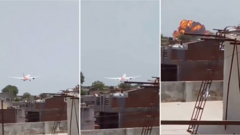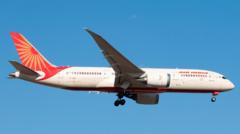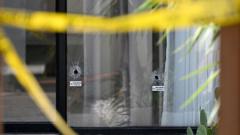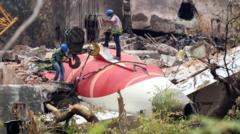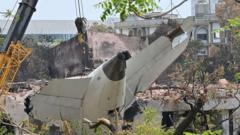As the investigation into the Air India Flight 171 crash unfolds, experts analyze possible causes, including engine failure, maintenance errors, and pilot actions. With crucial data being collected from wreckage and black boxes, the investigation aims to piece together this tragic event that has shocked the aviation industry.
"Investigating the Tragic Air India Crash: Anatomy of a Mystery"
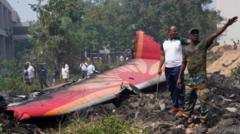
"Investigating the Tragic Air India Crash: Anatomy of a Mystery"
A deep dive into the investigation of Air India Flight 171, which faced a catastrophic plunge shortly after take-off, raising critical questions about aviation safety.
---
The recent crash of Air India Flight 171 in Ahmedabad has triggered a thorough investigation amidst widespread concerns over aviation safety. The Boeing 787 Dreamliner was airborne for less than 40 seconds before it tragically plummeted into a populated area, killing passengers and crew members.
Investigators are now faced with dissecting the wreckage and evaluating data captured in the aircraft’s cockpit voice and flight data recorders, commonly dubbed the "black boxes." According to international aviation protocols laid out by the UN's ICAO, a preliminary report is expected within 30 days, while a comprehensive final report may take up to a year to complete.
The ill-fated flight, which was en route to London Gatwick, took off from Ahmedabad at 13:39 local time, carrying 242 passengers and substantial fuel. Within mere moments, a mayday call echoed before the aircraft lost altitude and crashed in flames, leaving behind a scene of chaos and destruction.
Experts deem this incident "the rarest of the rare," describing it as a controlled flight into terrain shortly after take-off—a scenario virtually unprecedented in aviation history. Among the hypotheses being explored are the possibility of simultaneous engine failure caused by bird strikes, improper mechanical adjustments, or even crew actions that could have inadvertently disrupted fuel supply to the engines.
Investigators are expected to examine damage to the engines, as this could reveal whether the turbines were operational at the time of impact; discrepancies in turbine fractures offer critical clues into engine performance. The black boxes will shed further light, maintaining audio and extensive flight data that record various operational parameters, including power settings, thrust levels, and cockpit communications.
The investigation will proceed by closely analyzing whatever evidence is found in the wreckage, from cables to possible engine issues, with initial insights likely emerging from the engines' condition. If it is determined that the engines were functioning, the inquiry will shift to inspecting the aircraft’s flaps and slats, which are crucial for lift during critical phases of flight.
The investigation process involves a collaborative effort amongst Indian aviation authorities and global consultants, including experts from Boeing and the NTSB. While initial inspections of Air India’s 787 fleet have not raised major safety concerns, the ongoing inquiry could lead to significant developments, especially if systemic issues are discovered that could affect the worldwide fleet.
Investigators will triangulate data from multiple sources, including maintenance records, the history of prior operations, and flight logs. Pilot training and performance records will also come under scrutiny to ascertain their response to emergencies, particularly engine failure scenarios.
As this complex investigation unfolds, the aviation community awaits early indicators to understand the causes behind this tragic accident, which underscores the necessity for continual inspection and vigilance within aviation safety protocols. With advancements in technology allowing for detailed data collection, the investigation aims to prevent future tragedies as it seeks to decode what led to the flight's catastrophic demise.
The recent crash of Air India Flight 171 in Ahmedabad has triggered a thorough investigation amidst widespread concerns over aviation safety. The Boeing 787 Dreamliner was airborne for less than 40 seconds before it tragically plummeted into a populated area, killing passengers and crew members.
Investigators are now faced with dissecting the wreckage and evaluating data captured in the aircraft’s cockpit voice and flight data recorders, commonly dubbed the "black boxes." According to international aviation protocols laid out by the UN's ICAO, a preliminary report is expected within 30 days, while a comprehensive final report may take up to a year to complete.
The ill-fated flight, which was en route to London Gatwick, took off from Ahmedabad at 13:39 local time, carrying 242 passengers and substantial fuel. Within mere moments, a mayday call echoed before the aircraft lost altitude and crashed in flames, leaving behind a scene of chaos and destruction.
Experts deem this incident "the rarest of the rare," describing it as a controlled flight into terrain shortly after take-off—a scenario virtually unprecedented in aviation history. Among the hypotheses being explored are the possibility of simultaneous engine failure caused by bird strikes, improper mechanical adjustments, or even crew actions that could have inadvertently disrupted fuel supply to the engines.
Investigators are expected to examine damage to the engines, as this could reveal whether the turbines were operational at the time of impact; discrepancies in turbine fractures offer critical clues into engine performance. The black boxes will shed further light, maintaining audio and extensive flight data that record various operational parameters, including power settings, thrust levels, and cockpit communications.
The investigation will proceed by closely analyzing whatever evidence is found in the wreckage, from cables to possible engine issues, with initial insights likely emerging from the engines' condition. If it is determined that the engines were functioning, the inquiry will shift to inspecting the aircraft’s flaps and slats, which are crucial for lift during critical phases of flight.
The investigation process involves a collaborative effort amongst Indian aviation authorities and global consultants, including experts from Boeing and the NTSB. While initial inspections of Air India’s 787 fleet have not raised major safety concerns, the ongoing inquiry could lead to significant developments, especially if systemic issues are discovered that could affect the worldwide fleet.
Investigators will triangulate data from multiple sources, including maintenance records, the history of prior operations, and flight logs. Pilot training and performance records will also come under scrutiny to ascertain their response to emergencies, particularly engine failure scenarios.
As this complex investigation unfolds, the aviation community awaits early indicators to understand the causes behind this tragic accident, which underscores the necessity for continual inspection and vigilance within aviation safety protocols. With advancements in technology allowing for detailed data collection, the investigation aims to prevent future tragedies as it seeks to decode what led to the flight's catastrophic demise.



